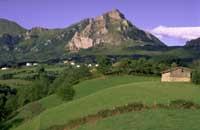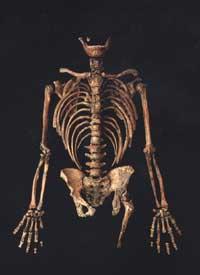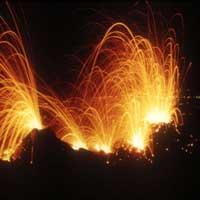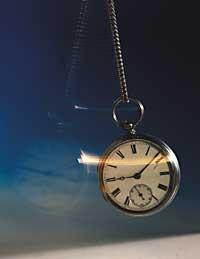Age of stones; mountains are not always old
2004/02/29 Roa Zubia, Guillermo - Elhuyar Zientzia

The young mountain is a mountain that is born after the old mountain; it is in sight. But, how can you know when a mountain or a stone is? In the trees you can know as much as cutting the trunk, since each year has left a ring. But in the mountains rings are not engraved, the year leaves no trace.
And what do they tell me about paleontologists? To determine the age of fossils, the game of geologists is maintained. Some say they know the age of the fossil before testing the 14 carbon, among other things because they have taken it under a sediment of several years. But how do you know the age of sediment?

The secret is in radioactive isotopes. The famous carbon-14 is one of them. The radioactive character means that the atoms of this material progressively lose the particles of the nuclei. Consequently, one nucleus is transformed into another. For example, the carbon atom 14 evolves over time to 14 nitrogen. However, this change takes a long time to occur. In fact, in a set of 14 carbon atoms, half of them must spend 5,730 years to become nitrogen. And so many others will be necessary for half of the remaining ones to become nitrogen. That is why it is called semi-life. It is an important concept. You can measure the amount of 14 carbon atoms that a fossil has and calculate approximately the age of the fossil if you know how much it had in its lifetime.
For us 5,730 years is a long time, but not for paleontologists. For example, when this period of time has passed three times, 17,190 years, that is, the fossil remains only one of the eight carbons it had at the beginning and it is increasingly difficult to detect those that remain. And yet, there are few fossils that enter this period, most of them much older. Therefore, the 14 carbon is famous, but it does not serve to know the age of the fossil of a dinosaur or of the humans of Atapuerca. They have already lost almost all carbon 14 and can not be detected.

But not all radioactive isotopes disappear at the same speed. Some have an average life of less than a second. Another billions of years. The 37 calcium atoms only need 175 milliseconds to disintegrate half. In the case of Uranium-238, on the contrary, 4,500 million years are needed. And that is why the second is used to calculate the age of stones and not the first. Uranium-238 and potassium-40 and torium-232 and many others. In the case of these measures and carbon 14 the base is the same. It is, for example, to make accounts knowing how much uranium-238 a stone has and how much it had when it was created.
Do we have to believe geologists? How do you know that the average life of uranium-238 is 4.5 billion years and not 118,000 for example? I am sure that in both cases no one has been able to measure it. In fact, other times have been measured with great precision. The average life of the Neon 19 is 17.2 seconds, and that of Iodo-131 of 8.07 days, and that of Tritio, 3 of hydrogen, 12.26 years, etc. Geologists have seen that all measurable isotopes disintegrate with the same pattern, although the time scale varies from one to the other. Therefore, those who are not measurable follow the same pattern and it is not necessary to wait 5,730 years to confirm, for example, the semi-life of carbon 14. The behavior of the first years allows geologists to perform the calculation.

Thus, geologists measure the age of stones. However, something else has remained pending for us. We have not clarified everything. How can we know the amount of uranium-238 that the stones had at the time of the constitution of Txindoki or Anboto? This data is necessary to know the age of their stones. Geologists make an estimate. When the Earth was formed there was a quantity of uranium-238 and over time it is being lost. But in that loss, atoms do not simply disappear. In each radioactive decay, the atom of uranium-238 is transformed into lead 206. And lead 206 is stable. It is not radioactive. It does not disintegrate. Therefore, in places where a uranium-238 atom has been dissolved, geologists find a 206 lead atom. This data helps to calculate the age and quantity of original uranium.
It must be known whether a mountain or a stone is young or old. And, above all, we have to understand the theory behind all that. Geologists cannot of course give everything, just as all the arguments that seem accepted are not correct and it is possible that some day errors of the theory are detected. However, geologists have applied their most sensible theory at the moment. And they have found a way to know the past of the stones.
Published in 7K.

Gai honi buruzko eduki gehiago
Elhuyarrek garatutako teknologia





